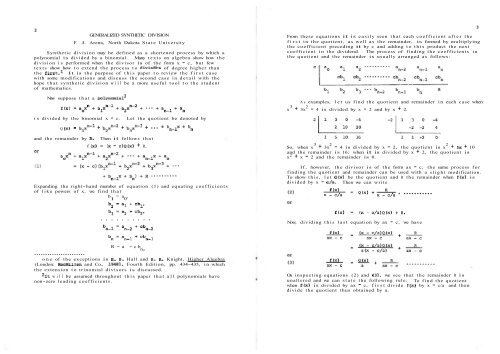Vol. 4 No 1 - Pi Mu Epsilon
Vol. 4 No 1 - Pi Mu Epsilon
Vol. 4 No 1 - Pi Mu Epsilon
Create successful ePaper yourself
Turn your PDF publications into a flip-book with our unique Google optimized e-Paper software.
GENERALIZED SYNTHETIC DIVISIONF. J. Arena, <strong>No</strong>rth Dakota State UniversitySynthetic division may be defined as a shortened process by which apolynomial is divided by a binomial. Many texts on algebra show how thedivision is performed when the divisor is of the form x - c, but fewtexts show how to extend the process to divisors of degree higher thanthe first.l It is the purpose of this paper to review the first casewith some modifications and discuss the second case in detail with thehope that synthetic division will be a more useful tool to the studentof mathematics.<strong>No</strong>w suppose that a polynomial2is divided by the binomial x - c.Q (x) = bxn-I + b ~ " - + ~ b ~ " - + ~ +and the remainder by R.Then it follows thatf (x) = (x - c)Q(x) + R,Let the quotient be denoted bybn-lx + bnExpanding the right-hand member of equation (1) and equating coefficientsof like powers of x, we find thatb = a1 0'From these equations it is easily seen that each coefficient after thefirst in the quotient, as well as the remainder, is formed by multiplyingthe coefficient preceding it by c and adding to this product the nextcoefficient in the dividend. The process of finding the coefficients inthe quotient and the remainder is usually arranged as follows:As examples, let us find the quotient and remainder in each case whenx 3 + 3x 2 - 4 is divided by x - 2 and by x + 2.So, when x 3 + 3x 2 - 4 is divided by x - 2, the quotient is x 2 + 5x + 10and the remainder is 16; when it is divided by x + 2, the quotient isx 2 + x - 2 and the remainder is 0.If, however, the divisor is of the form ax - c, the same process forfinding the quotient and remainder can be used with a slight modification.To show this, let Q(x) be the quotient and R the remainder when f(x) isdivided by x - c/a. Then we can write<strong>No</strong>w, dividing this last equation by ax - c, we have.......................R=a +cbn .one of the exceptions is H. S. Hall and S. R. Knight, Higher Algebra(London: MacMillan and Co., 19481, Fourth Edition, pp. 434-435, in whichthe extension to trinomial divisors is discussed.^~t will be assumed throughout this paper that all polynomials havenon-zero leading coefficients.On inspecting equations (2) and (31, we see that the remainder R isunaltered and we can state the following rule: To find the quotientwhen f(x) is divided by ax - c, first divide f(x) by x - c/a and thendivide the quotient thus obtained by a.
















